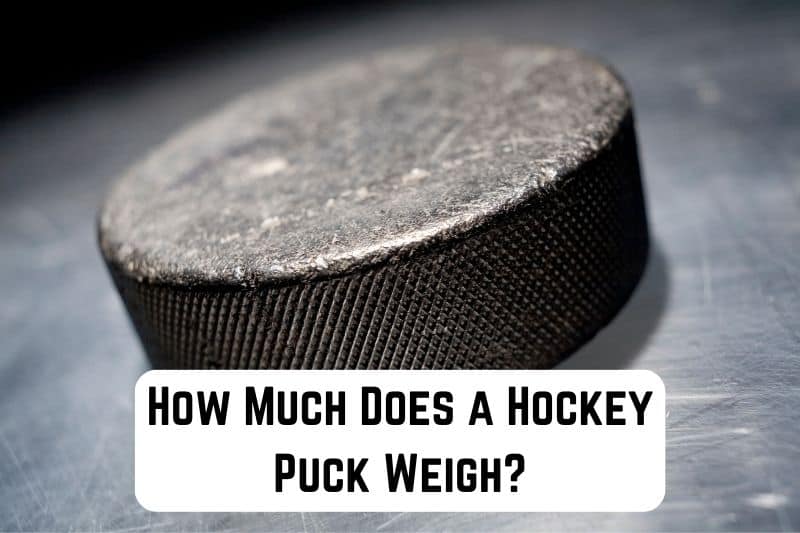When you’re watching an intense game of ice hockey, have you ever wondered how much the hockey puck flying across the rink actually weighs? It’s a fascinating question, and knowing the weight of a hockey puck can give you a better understanding of the force and skill required by the players as they shoot, pass, and defend during the game.
The weight of a hockey puck plays a significant role in the performance and stability on the ice. An official National Hockey League (NHL) puck weighs between 5.5 and 6 ounces, approximately 155 to 170 grams.
This weight is optimized to ensure the puck remains flat on the ice and glides smoothly during play, making it an essential aspect of the sport.
However, you may also find pucks designed for specific training purposes with different weights. For example, lighter blue pucks typically weigh 4 ounces, while heavier orange or red pucks weigh around 10 ounces. These variations help players develop their skills, control, and strength, but it’s the regulation 5.5 to 6-ounce puck that you’ll see in official games.
Read: How Much Does a Human Skeleton Weigh?
A standard ice hockey puck is 1 inch (25 mm) thick and 3 inches (76 mm) in diameter. The weight of a hockey puck usually falls between 5.5 and 6 ounces (156 and 170 grams). This consistent size and weight across various leagues and competitions ensures everyone a uniform playing experience.
Measuringly.com
Understanding Hockey Puck Specifications
Dimensions
As a hockey enthusiast, you need to know the dimensions of a hockey puck. A standard ice hockey puck is 1 inch (25 mm) thick and 3 inches (76 mm) in diameter. The weight of a hockey puck usually falls between 5.5 and 6 ounces (156 and 170 grams). This consistent size and weight across various leagues and competitions ensures everyone a uniform playing experience.
Material Composition
A hockey puck is made of vulcanized rubber, which is a material treated with heat and chemicals to modify its properties. This process makes the rubber more durable and dense, allowing the puck to withstand high-speed impacts and abrasive ice surfaces during gameplay. The color of a standard puck is black, which offers good visibility on the ice and contrasts against the whiteboards and markings.
Regulation Standards
The regulation standards for hockey pucks vary based on the level of competition, but the National Hockey League (NHL) and international competitions such as the Olympics and the World Championships follow a set of rules for the pucks.
According to these guidelines, an official NHL puck should weigh 6 ounces and have a diameter of 3 inches. However, some pucks designed for training or other purposes may weigh between 4 and 5 ounces, depending on their intended use.
Understanding hockey puck specifications is crucial to mastering your game and succeeding as a player. By familiarizing yourself with the dimensions, material composition, and regulation standards, you’ll become more knowledgeable about the equipment and its influence on the game’s dynamics.
Manufacturers and Production
Regarding hockey pucks, the manufacturing process and reputable brands play an essential role in ensuring they meet the required standards for professional and casual gameplay. In this section, we’ll explore popular brands and the quality and consistency of their hockey pucks.
Popular Brands
As a hockey aficionado, you may be familiar with some of the top brands that manufacture high-quality hockey pucks. Here are a few well-known companies that you can trust for premium pucks:
- Sher-Wood: They have been in hockey for decades and are the official supplier of NHL game pucks.
- A&R: A&R offers a variety of hockey pucks, including training and official game pucks that are known for their durability and performance.
- InGlasCo: This company produces the majority of NHL game pucks and is known for its consistency and quality.
Quality and Consistency
To ensure optimal performance during gameplay, hockey pucks must meet specific criteria regarding their weight, size, and material. Let’s examine some of the key factors:
- Weight: A regulation NHL hockey puck should weigh between 5.5 and 6 ounces (154-168 grams). This consistent weight allows for predictable movement on the ice, helping you improve your shot accuracy and passing skills.
- Size: The standard size of an NHL puck is 3 inches (7.6 cm) in diameter and 1 inch (2.54 cm) thick, which allows players to handle the puck efficiently.
- Material: Hockey pucks are typically made from vulcanized rubber, ensuring a perfect balance of hardness and durability to withstand rigorous gameplay.
When looking for a quality hockey puck, purchasing products from reputable brands and suppliers is essential. Doing so’ll ensure you have the best tools to fine-tune your skills and make the most out of every game.

Variations in Puck Weight
When it comes to hockey pucks, you might be surprised to learn that they come in different weights. In this section, we’ll explore some common variations in puck weight and their intended purposes.
Practice Pucks
Blue pucks are commonly used for practice, especially for younger or inexperienced players. They are lighter than the standard black pucks used in games and typically weigh around 4 ounces. The lighter weight makes it easier for beginners to develop their skills without the added difficulty of the heavier, game-ready pucks.
Youth Pucks
For youth hockey, the puck weight is adjusted to suit the age and skill level of the players. Some leagues use pucks weighing between 4 and 4.5 ounces, making them lighter than those used in college and professional games. This helps younger players develop their skills and more comfortable handling the puck on the ice.
Weighted Pucks
On the other end of the spectrum, weighted pucks, often orange in color, can help players improve their strength and shooting technique. These heavier pucks usually weigh around 10 ounces, making them significantly heavier than the standard 5.5-6 ounce pucks used during games.
By practicing with these heavier pucks, you’ll be able to gain confidence in your shot power and accuracy, making the standard puck feel even lighter in comparison.
In summary, hockey pucks have various weights for different skill levels and training purposes. As you continue to develop your proficiency in the sport, you’ll likely encounter and work with each of these variations during your hockey journey.
Read: How Much Does an Elk Weigh? Here’s the Answer!
Factors Influencing the Puck Movement
Ice Conditions
The ice surface plays a crucial role in the movement of a hockey puck. Smooth, well-maintained ice will allow the puck to glide effortlessly, whereas rough or slushy ice can hinder its movement.
As a player, it’s important to be aware of the ice conditions and adapt your handling accordingly. For example, on rough ice, you may need to keep the puck on your blade slightly longer to maintain control.
Puck Handling Skills
Your talent in handling the puck will directly affect its movement on the ice. Developing a feel for the puck’s weight and size will enable you to perform intricate maneuvers like stick handling and deception.
To improve your puck-handling skills, practice various drills focusing on hand-eye coordination and stick movements. Remember, mastery in puck control will give you an edge against your opponents.
Shooting Techniques
The technique you use when shooting the puck will also influence its movement. The three primary types of hockey shots – wrist, slap, and snap – each produce different puck trajectories and speeds. To become a versatile player, it’s important to be proficient in each type of shot.
Experiment with different grips, body positions, and stick angles to discover what works best for you in various game situations. The more versatile your shooting techniques are, the more unpredictable and successful you’ll be on the ice.







